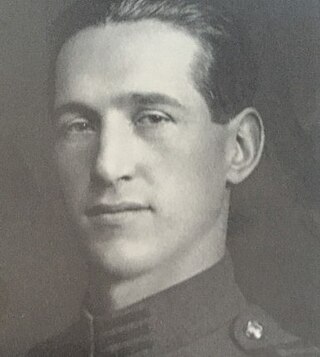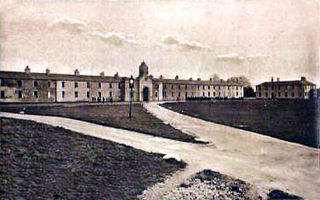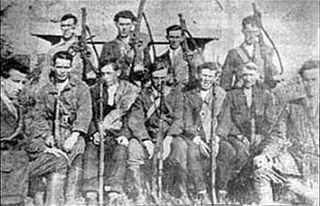
Kilflynn is a village and a civil parish in north County Kerry, Ireland. It is 11 km north-east of Tralee just off the N69 road from Tralee to Listowel.

Augustine Mary Moore Stack was an Irish republican and politician who served as Minister for Home Affairs from 1921 to 1922. He was a Teachta Dála (TD) from 1918 to 1927.
The Dublin Guard was a unit of the Irish Republican Army during the Irish War of Independence and then of the Irish National Army in the ensuing Civil War.

The executions during the Irish Civil War took place during the guerrilla phase of the Irish Civil War. This phase of the war was bitter, and both sides, the government forces of the Irish Free State and the anti-Treaty Irish Republican Army (IRA) insurgents, used executions and terror in what developed into a cycle of atrocities. From November 1922, the Free State government embarked on a policy of executing Republican prisoners in order to bring the war to an end. Many of those killed had previously been allies, and in some cases close friends, of those who ordered their deaths in the civil war. In addition, government troops also summarily executed prisoners in the field on several occasions. The executions of prisoners left a lasting legacy of bitterness in Irish politics.

David Neligan, known by his soubriquet "The Spy in the Castle", was a crucial figure involved in the Irish War of Independence (1919–21) and subsequently became Director of Intelligence for the Irish Army after the Irish Civil War (1922–23).
Stephen Fuller was an Irish Fianna Fáil politician who served as a Teachta Dála (TD) for the Kerry North constituency from 1937 to 1943.

Ballyseedy is a townland in County Kerry, Ireland. It was historically situated in the parish of Ballyseedy, within the barony of Trughanacmy. The townland contains a number of notable landmarks, including Ballyseedy Wood, a bridge over the Ballycarty River and a ruined Protestant church. There is also a large restored castle which is in use as a hotel.
This is a timeline of the Irish Civil War, which took place between June 1922 and May 1923. It followed the Irish War of Independence (1919–1921), and accompanied the establishment of the Irish Free State as an entity independent from the United Kingdom of Great Britain and Ireland.

Paddy Daly (1888–1957) sometimes referred to as Paddy O'Daly, served in the Irish Republican Army during the Irish War of Independence and subsequently held the rank of major-general in the Irish National Army from 1922 to 1924.

The National Army, sometimes unofficially referred to as the Free State army or the Regulars, was the army of the Irish Free State from January 1922 until October 1924. Its role in this period was defined by its service in the Irish Civil War, in defence of the institutions established by the Anglo-Irish Treaty. Michael Collins was the army's first commander-in-chief until his death in August 1922.

Ballymullen Barracks is an Irish military installation at Tralee, County Kerry in Ireland.
Denis ('Denny') Curran was an Irish footballer and Fianna Fáil political figure.
Niall Charles Harrington, born in Dublin, was an Irish soldier, officer, military intelligence director, writer and broadcaster, campaigner for the memory of Charles Stuart Parnell and a union representative. His military career spanned the period from the War of Independence through to his retirement as a senior intelligence officer in 1959. During this time he wrote and narrated various historical features for different media. His Civil War memoirs were developed into a book, Kerry Landing, which was extended and published posthumously.

Gortclohy is a townland of County Kerry, Ireland.

Fahavane is a townland of County Kerry, Ireland.

Timothy Lyons, a.k.a. Aero or Aeroplane, was an Irish Republican Army (IRA) soldier who fought with the Anti-Treaty side during the Irish Civil War. After a three-day siege by Free State forces at Clashmealcon, County Kerry, he died after falling from a cliff onto rocks and then being shot.
Reginald Walter Stenning was a British Army deserter who joined the Irish Republican Army (IRA), fighting on the anti-Treaty side in the Civil War. After being captured by Free State forces he was beaten and executed.
Edmond Greaney [also 'Edward', 'Eamonn/Eamon' and 'Greany' on historical documents] was a farm labourer and IRA soldier who fought on the anti-Treaty side in the Irish Civil War in north Kerry. He was captured by Free State forces and executed after the last major action of the War.
Thomas McGrath was an IRA soldier who fought on the anti-Treaty side in the Irish Civil War in north Kerry. He drowned after trying to escape a siege by Irish Free State forces at Clashmealcon during what was the last major military action of the War.
Patrick O'Shea was a farm labourer and IRA soldier who fought on the anti-Treaty side during the Irish Civil War in north Kerry. He died after falling from a cliff trying to escape from Irish Free State forces in a siege at Clashmealcon in the last major military action of the civil war.










